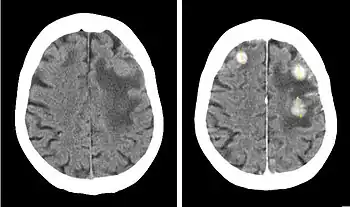Ioxaglic acid
 | |
| Clinical data | |
|---|---|
| Trade names | Hexabrix |
| AHFS/Drugs.com | FDA Professional Drug Information |
| Routes of administration | Intravascular, intraarticular, by mouth |
| ATC code | |
| Legal status | |
| Legal status |
|
| Pharmacokinetic data | |
| Protein binding | 14% |
| Metabolism | None |
| Elimination half-life | 92 min |
| Excretion | Unchanged via kidneys |
| Identifiers | |
IUPAC name
| |
| CAS Number | |
| PubChem CID | |
| DrugBank | |
| ChemSpider | |
| UNII | |
| KEGG | |
| ChEMBL | |
| CompTox Dashboard (EPA) | |
| ECHA InfoCard | 100.055.945 |
| Chemical and physical data | |
| Formula | C24H21I6N5O8 |
| Molar mass | 1268.886 g·mol−1 |
| 3D model (JSmol) | |
SMILES
| |
InChI
| |
Ioxaglic acid (trade name Hexabrix) is pharmaceutical drug used as an iodinated contrast medium for X-ray imaging. It has low osmolality (relatively few molecules per volume), typically resulting in fewer side effects than high-osmolality media.[1] It is manufactured by Guerbet, but marketing in the US has been discontinued.[2] As of 2021, it may still be available in some European countries.[3]
It is applied in form of its salts, ioxaglate meglumine and ioxaglate sodium.[2]
Medical uses
Uses include angiography (imaging of blood vessels, including those of the brain and heart), arthrography (imaging of joints), urography (imaging of the urinary system), hysterosalpingography (imaging of the uterus and Fallopian tubes), imaging of the gastrointestinal tract, and endoscopic retrograde cholangiopancreatography (ERCP; imaging of the biliary and pancreatic ducts).[4]
Contraindications
Ioxaglic acid is contraindicated in people with hyperthyreosis because of the drug's iodine content. It must not be used for myelography (spinal cord imaging), for hysterosalpingography in women who are pregnant or have an acute inflammation in the pelvic region, or for arthrography if the joint is infected.[2][4]
Adverse effects
Adverse effects include reactions at the injection site, such as a hot or painful feeling as well as general reactions such as nausea and vomiting. All of these are usually mild and transient. Allergy-like effects such as itching, sneezing, coughing and yawning can be the first sign of severe adverse reactions, especially a shock.[4]
Accidental intrathecal administration (into the spinal canal) can result in life-threatening reactions such as convulsions, cerebral (brain) edema or cerebral bleed.[2]
Interactions
Iodine-131, a radioactive isotope used for thyroid imaging (scintigraphy) and therapy of thyroid cancers, can be less effective when used within two to six weeks after application of ioxaglic acid because of residual iodine in the body.[4]
Pharmacology
Chemistry and mechanism of action

Ioxaglic acid is an iodine-containing, water-soluble radiocontrast agent. The iodine atoms readily absorb X-rays, resulting in a higher contrast of X-ray images. It has a low osmolality of 600 mosm/kg water at 37 °C (99 °F), meaning that the solution has a relatively low concentration of molecules; this is usually associated with fewer adverse effects than high-osmolality contrast agents.[2][4]
Pharmacokinetics
After injection into a vein, 14% of the circulating ioxaglic acid is bound to blood plasma proteins, which is unusually high for a water-soluble iodinated contrast agent.[5] The substance is distributed in the body with a half-life of 12 minutes (range 4 to 17 minutes) and eliminated in unmetabolized (unchanged) form via the kidneys with a half-life of 92 minutes (range 61 to 140 minutes).[2] In people with kidney failure, it is eliminated via the bile duct, saliva or sweat.[4]
References
- ↑ Meijenhorst GC, de Bruin JN (August 1980). "Hexabrix (ioxaglate), a new low osmolality contrast agent for lumbar epidural double-catheter venography". Neuroradiology. 20 (1): 29–32. doi:10.1007/bf00346858. PMID 6999377. S2CID 39778683.
- 1 2 3 4 5 6 Hexabrix FDA Professional Drug Information. Accessed 2021-03-26.
- ↑ "Ioxaglic acid: List of nationally authorised medicinal products" (PDF). European Medicines Agency. 31 October 2018.
- 1 2 3 4 5 6 Haberfeld H, ed. (2020). Austria-Codex (in German). Vienna: Österreichischer Apothekerverlag. Hexabrix 320 mg Jod/ml-Ampullen.
- ↑ Krause W, Niehues D (1996). "Biochemical characterization of x-ray contrast media". Invest. Radiol. 31 (1): 30–42. doi:10.1097/00004424-199601000-00006. PMID 8850363.